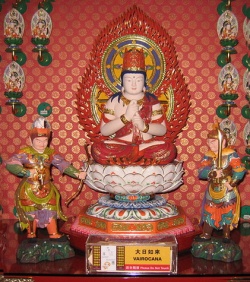Seven-point posture of Vairochana
Seven-point posture of Vairochana (Skt. saptadharma-vairocana; Wyl. rnam snang chos bdun; Tib. nam nang chö dün):
- Legs crossed
- Hands in the lap or on the knees
- Back (spine straight)
- Shoulders spread like a vulture’s wings
- Head and Neck (chin slightly lowered)
- Mouth (tip of the tongue touching the palate)
- Eyes (gazing past the tip of the nose).[1]
In his Stages of Meditation, Kamalashila writes:
- Then, they should seat themselves on a comfortable seat, either in the full lotus posture of Vairochana or the half-lotus posture. Their eyes should not be open too wide, nor too tightly closed, but focused on the tip of the nose. Their body should not be bent forward or backward, but kept straight, and their attention turned inwards. Their shoulders should rest evenly, and the head should not be tilted back or forward or to either side. The nose should be in line with the navel. The teeth and lips should rest in their natural state, and the tongue should touch the upper palate. Inhalation and exhalation should be just barely discernable, gentle, soft and natural, without undue noise, effort or agitation.
Footnotes
- ↑ These points are listed in different orders in different sources. This follows the order as found in Khenpo Ngakchung’s Zindri, page 42.
Source
RigpaWiki:Seven-point posture of Vairochana
Seven-point posture of Vairochana A special posture for meditation, in which parts of our body adopt a particular position:
(1) sitting on a comfortable cushion with the legs crossed in the vajra posture (in which the feet are placed upon the opposite thighs),
(2) the back straight,
(3) the head inclined slightly forward,
(4) the eyes remaining open slightly, gazing down the nose,
(5) the shoulders level,
(6) the mouth gently closed, and
(7) the right hand placed upon the left, palms up, four finger widths below the navel with the two thumbs touching just above the navel.
